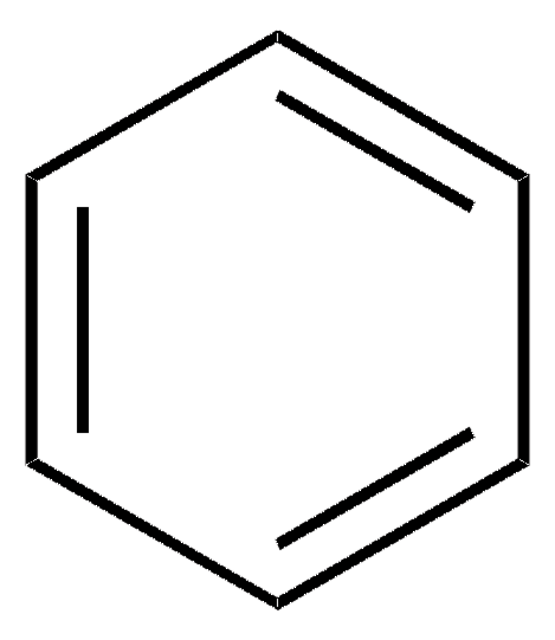32212
Benceno
puriss. p.a., reag. Ph. Eur., ≥99.7%
About This Item
Productos recomendados
agency
ISO
USP/NF
reag. Ph. Eur.
Quality Level
vapor density
2.77 (vs air)
vapor pressure
166 mmHg ( 37.7 °C)
74.6 mmHg ( 20 °C)
grade
puriss. p.a.
assay
≥99.7%
form
liquid
autoignition temp.
1043 °F
expl. lim.
8 %
impurities
≤0.0002% free alkali (as NH3)
≤0.0004% free acid (as HCl)
≤0.001% non-volatile matter
≤0.03% water (Karl Fischer)
≤1 ppm thiophene
color
APHA: ≤10
refractive index
n20/D 1.5000-1.5020
n20/D 1.501 (lit.)
bp
80 °C (lit.)
mp
5.5 °C (lit.)
transition temp
solidification point ≥5.2 °C
density
0.874 g/mL at 25 °C (lit.)
cation traces
Al: ≤0.5 mg/kg
B: ≤0.02 mg/kg
Ba: ≤0.1 mg/kg
Ca: ≤0.5 mg/kg
Cd: ≤0.05 mg/kg
Co: ≤0.02 mg/kg
Cr: ≤0.02 mg/kg
Cu: ≤0.01 mg/kg
Fe: ≤0.1 mg/kg
Mg: ≤0.1 mg/kg
Mn: ≤0.02 mg/kg
Ni: ≤0.02 mg/kg
Pb: ≤0.01 mg/kg
Sn: ≤0.1 mg/kg
Zn: ≤0.01 mg/kg
SMILES string
c1ccccc1
InChI
1S/C6H6/c1-2-4-6-5-3-1/h1-6H
InChI key
UHOVQNZJYSORNB-UHFFFAOYSA-N
¿Está buscando productos similares? Visita Guía de comparación de productos
Categorías relacionadas
General description
Application
Other Notes
signalword
Danger
Hazard Classifications
Aquatic Chronic 3 - Asp. Tox. 1 - Carc. 1A - Eye Irrit. 2 - Flam. Liq. 2 - Muta. 1B - Skin Irrit. 2 - STOT RE 1
target_organs
Blood
Storage Class
3 - Flammable liquids
wgk_germany
WGK 3
flash_point_f
12.2 °F
flash_point_c
-11 °C
Certificados de análisis (COA)
Busque Certificados de análisis (COA) introduciendo el número de lote del producto. Los números de lote se encuentran en la etiqueta del producto después de las palabras «Lot» o «Batch»
¿Ya tiene este producto?
Encuentre la documentación para los productos que ha comprado recientemente en la Biblioteca de documentos.
Los clientes también vieron
Nuestro equipo de científicos tiene experiencia en todas las áreas de investigación: Ciencias de la vida, Ciencia de los materiales, Síntesis química, Cromatografía, Analítica y muchas otras.
Póngase en contacto con el Servicio técnico







